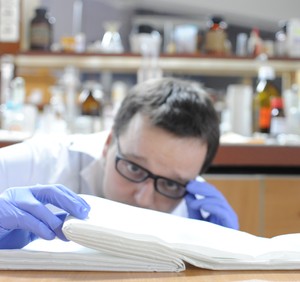Researchers from the Institute of Physical Chemistry of the Polish Academy of Sciences (IPC PAS) have conducted studies to establish methods of forming multi layers of liquid crystals by compressing it from the sides. For the purpose of the study, researchers poured micro litres of liquid crystals on a water surface in order to form an orderly single molecule layer.
 Jan Paczesny, a PhD student from the Institute of Physical Chemistry of the Polish Academy of Sciences in Warsaw, presents the roll-over mechanism of liquid crystal layers on the water surface that is responsible for formation of the 9-layer film. (Source: IPC PAS, Grzegorz Krzy¿ewski)
Jan Paczesny, a PhD student from the Institute of Physical Chemistry of the Polish Academy of Sciences in Warsaw, presents the roll-over mechanism of liquid crystal layers on the water surface that is responsible for formation of the 9-layer film. (Source: IPC PAS, Grzegorz Krzy¿ewski)
These monolayers were compressed with a device called the Langmuir trough, which consists of two hydrophilic barriers. When the distance between these two barriers is reduced, the pressure in the monolayer increases thus leading to the formation of multi layers.
Though it has been clearly established that under proper conditions, liquid crystals can form three layers, sometimes they are known to form five layers too. Judging from inter molecular interactions, scientists have been able to establish that further compression of tri layers leads to the formation of six layers and when this is rolled over the trilayer again it becomes an ordered 9 layer. The research team also studied interactions between molecules that were not flexible enough. When compression is applied over such molecules they get pushed out of the water surface and they remain mono layered.
For practical purposes the ordered multi layers can be transferred from the water surface to a solid substrate like silicon wafer that is immersed many times and taken out from a bath made of water. However, this process leads to the washing out of some monolayers in certain compounds. Scientists hope that compound derivatives studied by them will be used for organic electronics in the future.